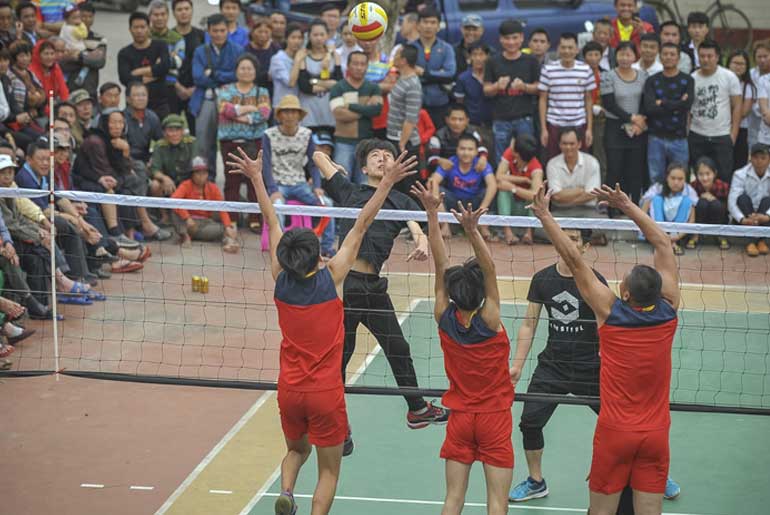The recent surge in popularity of village sports events in China has been remarkable, and these grassroots leagues have become a significant part of the country’s rural revitalization efforts. The events have gained immense traction among fans and locals due to their unique appeal and the passion of the participants. These local sports events have not only attracted billions of online viewers but have also spurred tourism in rural areas as spectators come to watch the amateur matches, experience the local culture, and enjoy the regional cuisine.
To further promote rural revitalization and professional sports, the General Administration of Sport of China, along with 11 other ministries and commissions, recently published an initiative to establish more than 100 rural sports events by 2035. The short-term goal is to boost mass sports in rural areas by 2025 and enhance sports mechanisms to facilitate rural revitalization. The initiative includes the construction of sports infrastructure in villages, the promotion of outdoor sports like mountaineering, cycling, water sports, aviation sports, and camping, the training of village sports educators, and the engagement of retired athletes as mentors.
These efforts align with the National Fitness Program for 2021 to 2025, announced by the State Council of China, which aims to increase regular sports participation among 38.5 percent of the population by 2025 and ensure convenient access to fitness facilities within a 15-minute walk.
The success of village sports events can be attributed to the genuine love and passion of the local people. These events feature non-professional players from different backgrounds, including students, farmers, and drivers, who come together to participate in sports activities. The absence of professional players and the authentic grassroots nature of these events have garnered widespread appeal. The key to organizing successful events lies in selecting suitable sports that are based on local conditions and involve the masses. It is essential to consider the availability of sports facilities and the number of participants in a particular region.
Combining sports with local culture has proven to be a winning formula for the success of village sports events. By incorporating the cultural heritage of a region, these events create a unique identity and attract a broader audience. For example, the soccer league in Rongjiang County combined the local culture of the region with the sport’s popularity, leading to its tremendous success. Similarly, events like the Naadam festival in Inner Mongolia and the lion dance in Guangdong Province have blended sports with local traditions, drawing people of all ages and fostering a sense of community.
By integrating grassroots sports events with local culture, China can make a lasting impact on rural revitalization. These events not only promote sports participation but also drive tourism, enhance regional development, and stimulate the consumption of local specialties. To ensure the sustainability of these events, it is crucial to improve public services, strengthen tourism infrastructure, and provide ongoing support for local communities.
Love and passion
Cun Chao (Lit: village super league), a village soccer league established in Rongjiang county, Southwest China’s Guizhou Province, has become a huge sports phenomenon since May. The craze has had a positive impact on local tourism. During the recent Dragon Boat Festival, hotel reservations in Rongjiang increased by 15 times compared to the same period in 2019, according to China’s major travel platform qunar.com.
An army of media reporters across the country flocked to the county to cover the league as former Chinese men’s soccer team captain Fan Zhiyi led a local team from Northwest China’s Qinghai Province to compete in the county during the Dragon Boat Festival.
Fan was taken aback by the popularity of the event.
“It’s soccer at its purest form. That’s why everybody loves it,” said Fan, who was the first Chinese man to win the Asian Player of the Year in 2001.
Fans of these rural matches attributed its sensation to local people’s pure love and passion for soccer. No professional players. No tickets. The players hail from different ethnic groups and all walks of life including drivers, students and farmers aging from 15 to over 40 years old.
“This is the day for which Rongjiang has been waiting for a long time,” Xu Bo, the magistrate of Rongjiang county, told the Global Times.
Since 2021, five local events have been organized in the county to attract tourists but all failed to prevail. Bullfighting, a folk event in the Qiandongnan Miao and Dong Autonomous Prefecture where Rongjiang is located, was canceled over safety concerns. A half marathon held in March was a flash in the pan and didn’t fuel economic growth. An effort to emulate the thriving basketball tournament in the neighboring Taijiang county was shelved since it was deemed too similar in nature.
Wang Dazhao, a Beijing-based senior sports commentator, told the Global Times that it’s actually very difficult for a county to organize a soccer or basketball tournament due to the lack of fields and the small number of participants.
Sports plus culture
Before trying for mass promotion of rural fitness, it’s better for these grass-roots events to be handled by local villagers as it is easier for them to access sports facilities, Wang said, noting it will take a long time given the economic gap between rural and urban areas.
Xu noted that combining sports and culture was the key to success in Rongjiang.
“It’s been proven that, no matter if it is a sports or culture event, it is difficult to make a single thing a phenomenon. The soccer league made a splash because we combined sports and the culture of Rongjiang together,” Xu said.
Whether it’s a soccer or a basketball tournament, sports have the power to knit people into a community, as these examples across China have shown. And this close-knit community is the perfect foundation for rural revitalization.
“Village soccer and basketball games represent the original form of sports returning to community-oriented activities,” Sun Lei, a Beijing-based soccer commentator, told the Global Times.
Sun also noted that many villages and towns in South China’s Hainan Province also have a deep love for volleyball, with regular matches attracting thousands of spectators. The participants include everyone from locals to talented individuals who have broken into professional sports.
Volleyball is ingrained in the rural life of Hainan. Wenchang, dubbed the “hometown of volleyball” in China, will host a local volleyball tournament on June 30 with 20 teams from local towns playing a total of 52 games. Wenchang is home to all kinds of volleyball courts, be they under a coconut tree or on the beach. Local villagers have even developed varieties such as “bench volleyball.”
Players are mainly township residents and villagers. In addition to the anticipated volleyball matches, this year’s competition features a mobile market covering all the destinations taking part in the tournament with the goal of promoting regional tourism, culture, food and specialty industries. To create a better tourism experience, this tournament will host local township cultural performances.
Jiang Yiyi, a professor of leisure sports and tourism at Beijing Sport University, told the Global Times that combing grass-roots sports events with local culture is the way to make a lasting impact on rural revitalization.
“The Naadam festival, and lion dance in South China’s Guangdong Province are good examples of regional events that blend sports and local culture,” said Jiang.
The Naadam festival, usually held from the 4th to 9th of the sixth month of the lunar calendar, is one of the most exciting and colorful festivals in the Inner Mongolia Autonomous Region. At the center of the festivities are fierce horse races as well as archery and wrestling competitions. It has become a mass artistic, and sports event participated in by people of all ages.
In addition to enjoying sports competitions, people also make good use of the gathering to make business connections or to exchange goods.
The soccer league in Guizhou gained immediate popularity because it’s a combination of local culture and a popular trend, she noted.
“We can not only watch soccer on the field but also enjoy ethnic performances off the field.”
“With floods of visitors drawn to Guizhou, we need to improve the public service sector to drive tourism and the consumption of local specialties. We can’t make it a one-off event,” she said.
In conclusion, village sports events in China have witnessed immense popularity and have the potential to contribute significantly to the country’s rural revitalization efforts. With strategic planning, investment in infrastructure, and the integration of sports and local culture, these grassroots leagues can continue to thrive and serve as catalysts for rural development and community engagement.
Disclaimer:
The information contained in this article is for educational and informational purposes only and is not intended as a health advice. We would ask you to consult a qualified professional or medical expert to gain additional knowledge before you choose to consume any product or perform any exercise.









